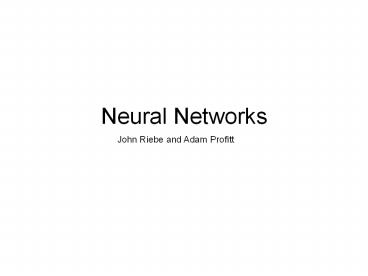Neural%20Networks - PowerPoint PPT Presentation
Title:
Neural%20Networks
Description:
Neural Networks John Riebe and Adam Profitt What is a neuron? Layers of the Neural Network Translation Functions Types of Neural Networks Training Neurons Matlab ... – PowerPoint PPT presentation
Number of Views:258
Avg rating:3.0/5.0
Title: Neural%20Networks
1
Neural Networks
John Riebe and Adam Profitt
2
What is a neuron?
PR Elements of the input vector W Weights ? Summer
b Bias n Sum of all P elements and
b ƒ Translation Function a Output
Weights Weights are scalars that multiply each
input element Summer The summer sums the input
elements, PR, together with the bias Bias A
bias is a number that is added to the total from
the summer Translation Function A translation
function is one of many specific functions used
in neural networking.
3
Layers of the Neural Network
- There are only three different types of layers in
a network - The Input Layer
- Moves the input vectors into each neuron of the
first hidden layer - The Hidden Layers
- Performs the bulk of the computations in most
networks - Hidden layers are not always required
- The Output Layer
- Each neuron in the output layer outputs its own
result
4
Translation Functions
5
Types of Neural Networks
- Perceptrons
- Used to classify data.
- Applies the hard-limit transfer function.
- Usually does not have any hidden layers.
- Linear Filters
- Used to solve linearly separable problems.
- Applies the linear transfer function.
- Backpropagation
- Generally has only one hidden layer.
- Can solve any reasonable problem.
- Hidden layers use sigmoid translations, outputs
use the linear transfer function
6
Training Neurons
Training a network sets the biases and weights in
each neuron
- To train a network you need
- A network
- An input
- A target vector
- There are many different types of
- training algorithms. To name a few
- Levenberg-Marquardt
- BFGS quasi-Newton
- Bayesian regularization
- One step secant
- Random order incremental
- Training algorithms
- Gives a network an input
- Receives the output
- Calculates error between output and target
- Adjusts weights and biases
- Goes back to step 1
Each time the algorithm goes through the steps is
called an epoch. Most networks go through many
epochs.
7
MatlabApplication
8
The newff Function
- Create a feed-forward network
- Syntax
- net newff
- net newff(PR,S1 S2...Si,TF1 TF2...TFi)
- Description
- net newff creates a new network with a dialog
box. - newff(PR,S1 S2...Si,TF1 TF2...TFi) takes,
- PR - R x 2 matrix of min and max values for R
input elements. - Si - Size of ith layer, for Nl layers.
- TFi - Transfer function of ith layer, default
'tansig'.
9
The train Function
Trains a neural network Syntax net
train(net,P,T) Description train trains a
network. train(net,P,T) takes, net - Neural
network object. P - Network inputs. T - Network
targets, default zeros.
10
The sim Function
The sim function simulates a neural network. This
function feeds the network the input, P, and
displays the results.
Syntaxsim(net,P) Descriptionsim simulates
neural networks. sim(net,P) takes, net - Network.
P - Network inputs.
11
Transfer Functions Revisited
- Transfer functions
- Hard-Limit
- a hardlim(n)
Outputs either a 1 or a 0
- Linear
- a purelin(n)
Outputs the scaled and summed input
- Log-Sigmoid
- a logsig(n)
Squeezes the input to between 0 and 1
- Tan-Sigmoid
- a tansig(n)
Squeezes the input to between -1 and 1
12
The Baum-Haussler Rule
The Baum-Haussler Rule is one of the most useful
rules for neural networks.
Nhidden (Ntrain Etolerance) / (Npts
Noutputs)
This rule helps you determine the maximum number
of neurons you will need for your network to
function properly.
This is NOT a law it will not work in all
situations. Sometimes you just have to use
another method.
13
Bibliography
Demuth, Howard and Mark Beale. Neural Network
Toolbox Users Guide. 1992-2003 URL
http//www.mathworks.com/access/helpdesk/help/tool
box/nnet/nnet.shtml

